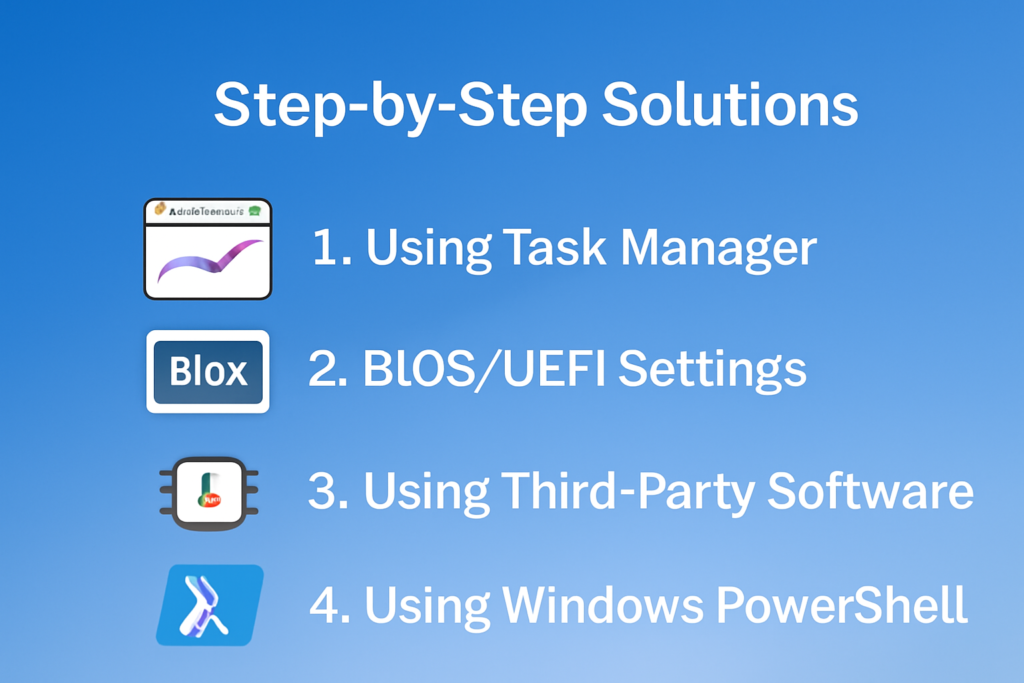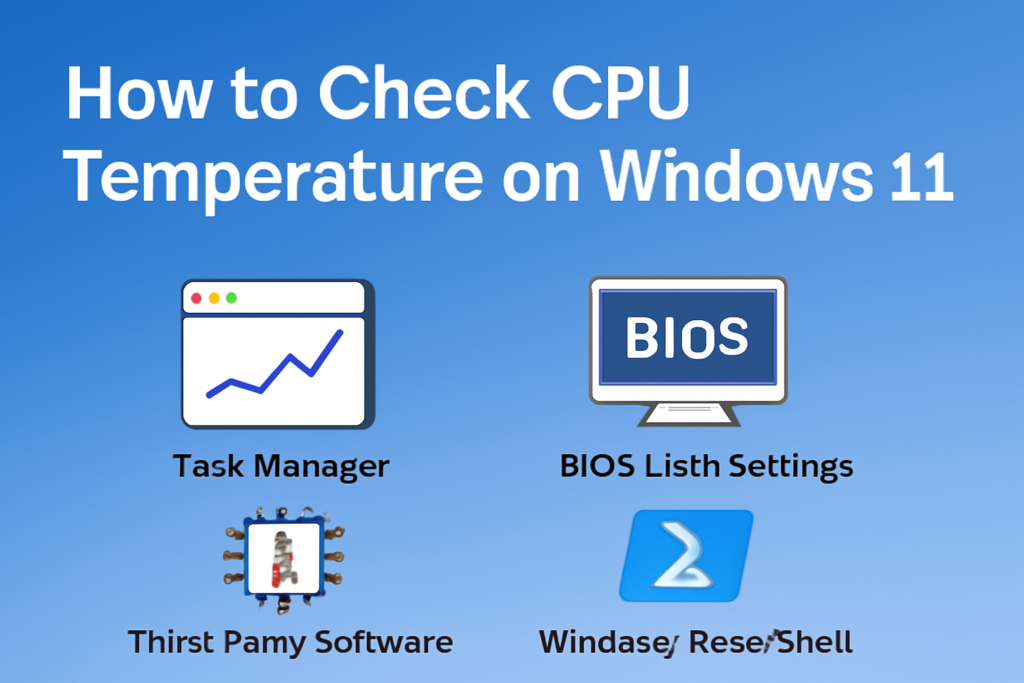How to Check CPU Temperature on Windows 11 is crucial for keeping your PC running smoothly. Overheating can lead to performance issues and long-term damage, but tracking your CPU’s temperature is easier than you think. In this guide, we’ll show you simple and effective methods to monitor your CPU temperature on Windows 11.
In this article, we’ll walk you through the simplest and most effective methods to check your CPU temperature on Windows 11, helping you keep your PC running cool and efficient.
Key Symptoms/Problems and How to Check CPU Temperature on Windows 11
Many Windows 11 users face a variety of issues related to overheating and high CPU temperatures. Some common symptoms that may indicate that How to Check CPU Temperature on Windows 11:
- Slow Performance: Your computer may feel sluggish, and applications may take longer to open or respond.
- Frequent Crashes or Freezing: If your computer shuts down unexpectedly or freezes, it could be a sign that your CPU is overheating.
- Loud Fan Noise: If your computer’s fan is running at full speed, it’s often trying to cool down an overheating CPU.
- Warning Messages: Some systems will notify you of high temperatures or thermal throttling.
These problems are often linked to the lack of monitoring and maintaining optimal CPU temperature levels. It’s important to identify these issues early on to prevent potential damage to your hardware.
Why This Happens
Overheating in CPUs is a common issue that can occur for several reasons. Understanding why your CPU temperature spikes can help you address the issue more effectively. Here are some common causes:
- Insufficient Cooling: A lack of proper airflow, a malfunctioning fan, or insufficient thermal paste can prevent heat from being dissipated properly.
- Heavy Workload: Running resource-intensive programs or multiple tasks at once can cause your CPU to overheat, especially if the cooling system is not powerful enough.
- Dust Accumulation: Dust can accumulate inside your computer, blocking airflow and causing the system to overheat.
- Aging Hardware: Over time, the thermal paste on your CPU may degrade, leading to inefficient heat transfer and higher temperatures.
- Faulty Sensors: Sometimes, a faulty sensor or inaccurate reading can show higher temperatures than the actual levels.
Understanding these causes will help you take the right steps to monitor and manage your CPU’s temperature effectively.
Solution Overview
There are several ways to check the CPU temperature on Windows 11. These methods range from using built-in tools to third-party software solutions. Here is a quick guide on the most common approaches:
| Method | Best For | Difficulty |
| Task Manager | Quick, no installation required | Easy |
| BIOS/UEFI Settings | Monitoring before bootup | Moderate |
| Third-Party Software | Detailed, real-time monitoring | Easy to Moderate |
| Windows PowerShell | Command-line enthusiasts | Moderate |
Each method has its own advantages and is suitable for different needs. Let’s dive into the step-by-step solutions.
Step-by-Step Solutions

1. Using Task Manager
The quickest way How to Check CPU Temperature on Windows 11 is through the Task Manager. Although Task Manager doesn’t directly display temperature, it shows performance metrics that can be helpful.
Steps:
- Right-click the Start menu and select Task Manager.
- Click on the Performance tab.
- Under the CPU section, you will see detailed information about your CPU usage, clock speed, and number of cores.
- While it doesn’t show temperature directly, you can monitor the CPU load and usage. If the load is high and performance is poor, your CPU may be running hot.
This method is useful for getting a quick overview of CPU usage, but it doesn’t provide a precise temperature reading.
Knowing how to check recently closed apps in Windows 11 can be incredibly useful for productivity and troubleshooting. It allows you to quickly reopen apps you may have accidentally closed or need to revisit. If you’re looking for a detailed guide on this topic, check out The Ultimate Guide on How to Check Recently Closed Apps in Windows 11 (2025).
2. Using BIOS/UEFI Settings
Another way to check your CPU temperature is by accessing the BIOS/UEFI firmware settings. This method is often more accurate but requires restarting your PC.
Steps:
- Restart your computer and press the key to enter BIOS (usually F2, Del, or Esc).
- Once in BIOS, navigate to the Hardware Monitor or PC Health section.
- Look for a field that displays the CPU Temperature.
- You can check the temperature here, but note that the BIOS only shows the temperature at startup, not under load.
This method is reliable but less convenient than using software that monitors temperature while the computer is running.
3. Using Third-Party Software
For detailed and real-time temperature monitoring, third-party software is often the best option. These tools are specifically designed to show the exact temperature of your CPU and even give you real-time data while you’re using your computer.
Popular third-party tools include:
Core Temp: A lightweight tool that shows the temperature of each individual CPU core.
HWMonitor: A powerful tool that provides comprehensive hardware monitoring, including CPU temperature, fan speed, and voltage.
Open Hardware Monitor: A free, open-source software that tracks various hardware components, including CPU temperature.
Steps for using Core Temp:
- Download and install Core Temp from the official website.
- Launch the program, and it will display your CPU temperature in the main window.
- The temperature is displayed in Celsius, and the program updates it in real-time, so you can monitor how it changes during use.
Using third-party software is by far the most accurate and convenient method How to Check CPU Temperature on Windows 11, as it provides real-time monitoring.
4. Using Windows PowerShell (Advanced)
For more advanced users who prefer command-line tools, Windows PowerShell can be used to check the CPU temperature, although this method requires additional scripting.
Steps:
- Press Windows + X and select Windows PowerShell (Admin).
- Type the following command and press Enter:
- Get-WmiObject -Class Win32_TemperatureProbe
- The output will display the temperature of your system’s components. However, this may not work on all systems, as some configurations may not support WMI probes for temperature monitoring.
This method is suitable for users who are comfortable with scripting and want a quick command-line solution.
Additional Tips or Pro Tips
Regular Cleaning: Dust buildup can cause overheating. Regularly clean your PC’s internals, especially the fans and air vents, to ensure proper airflow.
Use Thermal Paste: If you’re comfortable with disassembling your computer, reapplying thermal paste on your CPU can improve heat transfer and lower temperatures.
Monitor CPU Load: Sometimes, high temperatures are caused by unnecessary background processes. Use Task Manager or third-party tools to identify and close resource-hogging applications.
Upgrade Cooling System: If you’re consistently facing high temperatures, consider upgrading your PC’s cooling system, whether it’s by adding more case fans or upgrading the CPU cooler.
Official support page on managing system resources, which offers tips on improving your PC’s overall efficiency, including CPU management and performance settings. Visit the page for more details: Microsoft Support – Optimize Windows 11 Performance.
Conclusion
Keeping an eye on your CPU temperature is crucial for maintaining your computer’s performance and longevity. Whether you use the built-in Task Manager, BIOS/UEFI, third-party software, or Windows PowerShell, there are several ways to check your CPU temperature on Windows 11. Monitoring the temperature regularly helps prevent overheating issues, improving your PC’s stability and performance.
If you notice high temperatures, try some of the tips provided, such as cleaning your system or upgrading your cooling. Share this article with others who might find it helpful, and take action now to keep your system cool!
Frequently Asked Questions (FAQ)
Q 1. Why should I check the CPU temperature on Windows 11?
Answer: Checking your CPU temperature helps ensure that your computer is running at optimal levels. Overheating can lead to slow performance, crashes, and permanent hardware damage. Monitoring the temperature regularly helps you prevent these issues.
Q 2. How to Check CPU Temperature on Windows 11 without installing any software on Windows 11?
Answer: You can use the built-in Task Manager to monitor CPU usage, but it doesn’t provide a direct temperature reading. For more accurate monitoring, you would need third-party software or access to the BIOS/UEFI settings.
Q 3. What are the signs of a CPU overheating?
Answer: Common signs of an overheating CPU include slow performance, system crashes, unexpected shutdowns, or loud fan noise. If you notice these symptoms, it may be time to check your CPU temperature.
Q 4. Is it safe to leave my computer running with a high CPU temperature?
Answer: No, prolonged exposure to high temperatures can damage the CPU and other internal components. It is recommended to address overheating issues promptly by improving cooling solutions or using monitoring software to track the temperature.
Q 5. What is the ideal CPU temperature range for Windows 11?
Answer: The ideal CPU temperature is typically between 40°C to 60°C (104°F to 140°F) during normal usage. Under heavy load, temperatures up to 80°C (176°F) are acceptable, but anything higher could indicate a problem.
Q 6. Can BIOS help me check the CPU temperature?
Answer: Yes, accessing your computer’s BIOS/UEFI settings allows you to view the CPU temperature directly, though this method only shows the temperature at boot-up and not under normal operating conditions.
Q 7. What third-party software can I use to check the CPU temperature on Windows 11?
Answer: Popular tools for monitoring CPU temperature include Core Temp, HWMonitor, and Open Hardware Monitor. These programs provide real-time temperature readings and detailed hardware stats.
Q 8. How often should I check the CPU temperature?
Answer: It’s a good idea to monitor the CPU temperature regularly, especially during heavy use like gaming or video editing. You can set up alerts in third-party software to notify you if the temperature exceeds safe limits.




